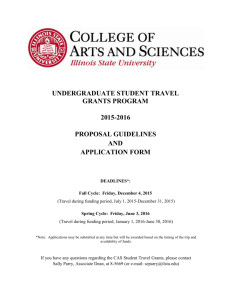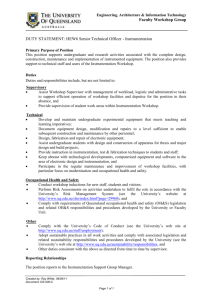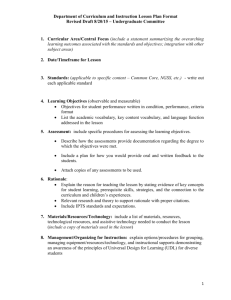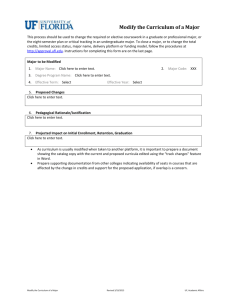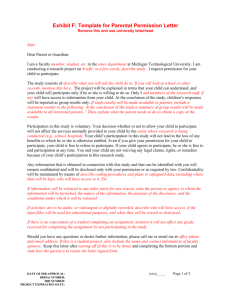Date: November 8, 2007
advertisement
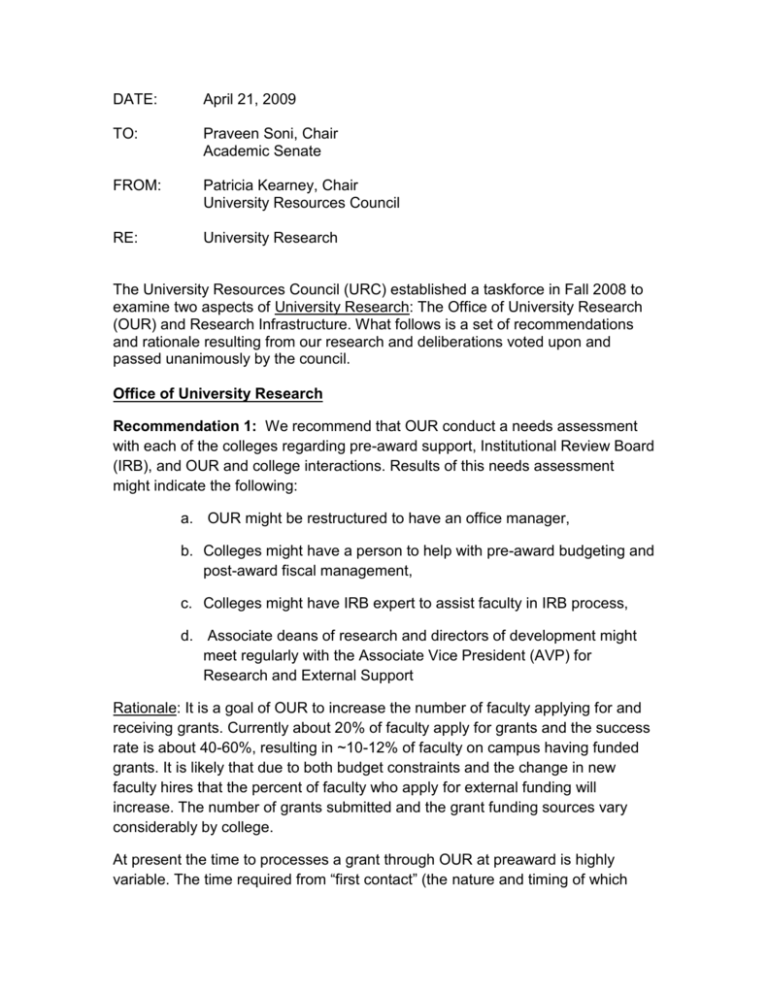
DATE: April 21, 2009 TO: Praveen Soni, Chair Academic Senate FROM: Patricia Kearney, Chair University Resources Council RE: University Research The University Resources Council (URC) established a taskforce in Fall 2008 to examine two aspects of University Research: The Office of University Research (OUR) and Research Infrastructure. What follows is a set of recommendations and rationale resulting from our research and deliberations voted upon and passed unanimously by the council. Office of University Research Recommendation 1: We recommend that OUR conduct a needs assessment with each of the colleges regarding pre-award support, Institutional Review Board (IRB), and OUR and college interactions. Results of this needs assessment might indicate the following: a. OUR might be restructured to have an office manager, b. Colleges might have a person to help with pre-award budgeting and post-award fiscal management, c. Colleges might have IRB expert to assist faculty in IRB process, d. Associate deans of research and directors of development might meet regularly with the Associate Vice President (AVP) for Research and External Support Rationale: It is a goal of OUR to increase the number of faculty applying for and receiving grants. Currently about 20% of faculty apply for grants and the success rate is about 40-60%, resulting in ~10-12% of faculty on campus having funded grants. It is likely that due to both budget constraints and the change in new faculty hires that the percent of faculty who apply for external funding will increase. The number of grants submitted and the grant funding sources vary considerably by college. At present the time to processes a grant through OUR at preaward is highly variable. The time required from “first contact” (the nature and timing of which varies) to actual grant submission is influenced by a large number of factors. Among these factors are the unique requirements of the granting agency, complexity of the budget, availability/responsiveness of the PI, availability/responsiveness of clearance officials, number of grants “in the processing queue” and looming, firm deadlines for other submissions. The preaward staff often must function in a triage mode because of unforeseen delays in the processing or inadequate lead-time. However, for the amount of grants and contracts currently being processed there is enough staff to manage the workload. IRB applications have been steady over the course of several years. There is a Director of Research Compliance who is 25% time and enough staff in the office for the workload demands. The amount of time to have an IRB application approved varies considerably by the nature of the research being conducted. The IRB committee is comprised of 12 faculty which is enough people but issues arise in time to respond (supposed to be 10 days) and there is not time for the board to calibrate. Research Infrastructure Research infrastructure may be defined as the tools, services, and installations needed for the research community to function and for the researchers to do their work. Categories include library research services, hardware, software, technical support and research space. Recommendation 1: Research is an integral component of undergraduate and graduate education. We call for the creation of a fixed infrastructure budget to support the cost of up-keep, repair, and replacement of research instrumentation, including instrument technicians. Rationale: The hardware and software needs necessary to perform research at a level that supports the education of students and is viable for eternal funding demands instrumentation and equipment at the cutting edge of technology. Such equipment or software packages generally have functional requirements beyond those required of their basic teaching counterpart. The funds to support acquisition of such resources are provided through Group II monies connected to new or renovated buildings, new faculty start-up funds, research grants written by faculty, operating and expense budgets, lottery funds, and SCAC awards. Most of these funding sources are one-time offerings that do not support future maintenance, repair, or replacement. In general, but particularly in tight budget periods, the large course activities take precedence and support for up-keep, repair, and replacement of research instrumentation and equipment, which impact a smaller number of students often takes a back seat. This lack of dedicated support for the research component of the mission hinders the progress of scholarly activities. Lacking a dedicated research instrumentation infrastructure budget leaves departments and colleges scrambling to identify immediately available funding to repair or replace instruments that need repair. Major research instrumentation holdings, while facilitating productive research programs, can become significant drains on faculty time and research funds. To allow faculty to focus on their most important responsibilities of teaching and research, it is critical that they not be overly distracted by other duties. It is most often time for research that is eroded when additional duties must be added to a full schedule. It is not in the best interest of the university, therefore, to have faculty devoting time to peripheral functions such as routine instrument maintenance. Shielding faculty from these time-intensive duties requires support staff to fill roles that do not require faculty expertise. There is a need to earmark operating funds for instrument maintenance and repairs as well as to support instrument technicians. Recommendation 2: Research is an integral component of undergraduate education. We recommend a call for the revision of the CSU State University Administrative Manual resource allocation formula to include research space for undergraduate students and faculty where appropriate. Recommendation 3: Recognizing the changing realities of research infrastructure, we recommend a call for the revision of the CSU State University Administrative Manual resource allocation formula for research space for graduate students. Rationale: In many undergraduate and graduate degree programs scholarly activity is a required component of the student’s education. This requirement is often mandated by the professional societies who certify the curriculum of the department’s graduates. In spite of the recognition of research as a component of faculty responsibility, and the importance of providing a suitable learning environment only provides research space for graduate students. It does not allocate research space for faculty or undergraduate research students. Given the importance (and in some cases, the requirement) that undergraduate students participate in scholarly activity as a component of their education, such an oversight handicaps the university as it undertakes its mandate. A lack of research space presents a significant impediment in departments where such space is at a premium. A shortage of research space influences decisions to replace tenure-track faculty or what research specialties will be sought in faculty hires. Pressure for space creates competition between faculty as “less research productive faculty” are forced into less adequate spaces. Shortages of space and other resources make it more difficult to keep research productive faculty members.
